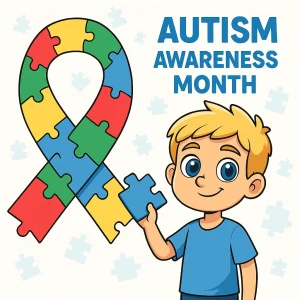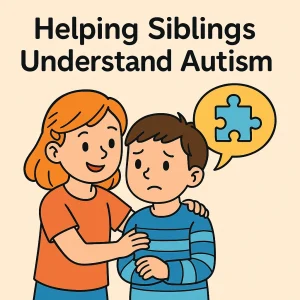High vs. Low-Functioning Autism: Understanding the Spectrum
Last Updated: September 25, 2024
Autism Spectrum Disorder (ASD) is a complex developmental condition that affects how people communicate, interact with others, and perceive the world around them. Because it’s called a spectrum, autism can show up in many different ways, with some individuals needing more support in daily life and others being quite independent. This wide range of behaviors and abilities is why no two people with autism are the same.
You may have heard the terms high-functioning and low-functioning autism used to describe different types of autism. While these labels are often used, they aren’t official medical terms and can sometimes be confusing. They are often based on how much support a person needs, rather than a clear-cut measure of their abilities or challenges.

What is High-Functioning Autism?
High-Functioning Autism (HFA) refers to individuals on the autism spectrum who generally have average or above-average intelligence and can live independently. While they might excel in areas like academics or specific hobbies, they often face challenges when it comes to social interactions and adjusting to changes in routine.
People with HFA usually have strong language skills and can communicate well, but understanding social cues—like body language or tone of voice—can be difficult. They might prefer predictable routines and feel uncomfortable when their day doesn’t go as planned.
Some common traits of individuals with high-functioning autism include:
- Repetitive behaviors, such as following the same routine daily or repeatedly focusing on a favorite activity.
- Intense focus on specific topics, like memorizing facts about a hobby or area of interest.
- Difficulty with flexibility, often struggling with unexpected changes or transitions.
- A strong preference for structure and routine to feel comfortable and in control.
While those with HFA may seem independent, their social challenges can affect relationships and how they handle new or unpredictable situations.
What is Low-Functioning Autism?
Low-Functioning Autism (LFA) refers to individuals on the autism spectrum who have significant intellectual disabilities and often require daily support for basic tasks like eating, dressing, or using the bathroom. While everyone with autism experiences it differently, individuals with LFA face more challenges in their everyday life due to their greater need for assistance.
People with LFA may have limited communication skills, meaning they might not use spoken language or only speak a few words. Instead, they often rely on alternative communication methods, such as picture boards, sign language, or apps designed to help them express their needs.
Some common characteristics of low-functioning autism include:
- Limited or non verbal communication, often using other tools to communicate.
- Difficulty processing sensory information, which can lead to discomfort in bright lights, loud noises, or crowded spaces.
- Behavioral challenges, including repetitive behaviors or self-injury, often as a response to stress or overstimulation.
- The need for constant support in everyday tasks, from basic hygiene to social interactions.
Individuals with LFA often require the help of caregivers and specialists to navigate daily life, and while they face more challenges, they can still benefit from therapies and support designed to enhance their quality of life.
How High- and Low-Functioning Autism Affects Individuals
Impact of High-Functioning Autism
For individuals with high-functioning autism (HFA), day-to-day life can present challenges, even though they may appear independent. Many people with HFA struggle with social interactions, often having difficulty understanding non-verbal cues like facial expressions or body language. This can make it hard for them to form relationships or fit into social situations.
Another common issue is rigid behavior patterns. Many individuals with HFA rely on structure and routine to feel comfortable. Changes in routine, even small ones, can lead to anxiety or frustration. While they might have strong language skills and excel in specific areas like academics, they often face challenges adjusting to unexpected situations.
In addition, people with HFA are more likely to experience sensory overload, where bright lights, loud noises, or crowded places can feel overwhelming. This sensory sensitivity can impact their ability to thrive in workplaces or schools, even though their intelligence and language skills might suggest they can handle it independently. The truth is, they often need support to manage these environments.
Also read: Social Communication Disorder: A Quick and Easy Guide
Impact of Low-Functioning Autism
On the other end of the spectrum, individuals with low-functioning autism (LFA) face more pronounced challenges. People with LFA often need help with everyday tasks, such as eating, dressing, or personal hygiene. They may not use spoken language and often rely on non-verbal communication tools like picture boards or apps to express their needs.
Their sensory sensitivities tend to be more intense, leading to behavioral challenges like meltdowns or self-injury when they feel overwhelmed. These behaviors can occur frequently and require constant attention and support from caregivers.
Families and caregivers play an essential role in supporting individuals with LFA, as they need continuous help in navigating daily life. Whether it’s managing their sensory challenges or assisting with communication, the high level of support required makes family involvement crucial.
Key Differences Between High- and Low-Functioning Autism
The key difference between high-functioning autism (HFA) and low-functioning autism (LFA) is the level of independence. People with HFA can generally live more independently, managing everyday tasks with minimal assistance. Their symptoms are usually milder, allowing them to excel in areas like academics or specific hobbies, though they still face challenges, particularly with social interactions and dealing with changes in routine.
In contrast, individuals with LFA often need ongoing, hands-on support for daily activities such as dressing, eating, and personal hygiene. Their communication skills are usually more limited, and they rely on tools like picture boards or communication apps to express themselves. Sensory sensitivities can also be more intense, leading to more frequent behavioral challenges, such as meltdowns or self-injury.
Despite these differences, it’s important to remember that autism is a spectrum. Each individual’s experience is unique, whether they are labeled high- or low-functioning. While these terms can help explain the level of support someone might need, they don’t fully capture the complexities of autism. Some individuals with LFA may have special talents, while those with HFA might still struggle with tasks others find simple.
High-Functioning vs. Low-Functioning Autism
| Feature | High-Functioning Autism | Low-Functioning Autism |
| Communication | Individuals typically have strong language skills and can communicate verbally. However, they may still struggle with the subtleties of conversation, such as tone or understanding sarcasm. | Communication is often limited or non-verbal. Individuals may rely on alternative methods like picture boards, apps, or gestures to express their needs. |
| Social Interaction | They may have difficulty understanding non-verbal cues, such as facial expressions or body language. Social interactions can be awkward or misunderstood. | Minimal to no social interaction. Individuals may not initiate or respond to social cues and may struggle to engage in relationships. |
| Independence | Can generally live independently or with minimal support. They often manage daily tasks but may struggle in complex situations or under stress. | Requires constant support for daily living activities such as dressing, eating, and hygiene. They may need a full-time caregiver. |
| Routine | Rigid but manageable. Individuals prefer structured routines and may get upset by sudden changes, but they can adapt with support. | Struggles with basic daily routines. Any changes or disruptions can lead to frustration or meltdowns, and they often need help to follow a routine. |
| Sensory Sensitivities | Can experience sensory overload, such as discomfort in loud, bright, or crowded environments. However, they may be able to manage these with coping strategies. | Sensory sensitivities are often frequent and intense. Individuals may become overwhelmed easily by noise, lights, or textures, leading to behavioral challenges. |
Conclusion
Autism is a spectrum, which means that every person with autism is different. The terms high-functioning and low-functioning can describe the kind of support someone might need, but they don’t show the full picture of what a person can achieve. With the right support, whether someone is labeled high- or low-functioning, they can still reach their potential in their own unique way.
Getting an early diagnosis is very important because it allows for personalized support that fits each person’s needs. Whether it’s therapy, communication tools, or help with daily tasks, having the right support can make a big difference in helping individuals with autism lead fulfilling lives. Platforms like Wellness Hub offer helpful resources for both children and adults with autism.
Frequently Asked Questions:
1. What is the difference between high-functioning and low-functioning autism?
High-functioning autism refers to individuals with average or above-average intelligence who can live independently but may struggle with social skills and routine changes. Low-functioning autism describes individuals with significant intellectual disabilities who need daily support for basic tasks and often have limited communication skills.
2. Can someone with high-functioning autism live independently?
Yes, many individuals with high-functioning autism can live independently. They may still need some support, especially with social interactions, but they generally manage their daily lives.
3. How does low-functioning autism affect daily life?
Low-functioning autism often affects an individual’s ability to manage everyday tasks like dressing, eating, or communicating. People with low-functioning autism typically require constant support from caregivers for their daily needs.
4. Is autism a spectrum?
Yes, autism is a spectrum, meaning that the severity of symptoms and level of support needed varies widely among individuals. Some may need minimal help, while others require significant daily assistance.
5. What are the early signs of high- and low-functioning autism?
For high-functioning autism, early signs might include difficulty with social interactions, rigid routines, and intense focus on specific topics. In low-functioning autism, signs often include delayed speech, non-verbal communication, and difficulty with basic tasks.
6. Can low-functioning autism improve over time?
While individuals with low-functioning autism often need ongoing support, early intervention and personalized therapies can help improve communication and daily functioning skills.
7. Why are the terms high-functioning and low-functioning autism considered outdated?
These terms can be misleading because they don’t fully capture the complexity of a person’s abilities. Autism is a spectrum, and people with both high- and low-functioning autism may excel in certain areas while struggling in others.
8. How can early diagnosis help individuals with autism?
Early diagnosis allows for tailored therapies and interventions, which can make a big difference in helping individuals with autism, whether high- or low-functioning, reach their full potential.
9. What kind of support do people with low-functioning autism need?
People with low-functioning autism usually need hands-on support for daily tasks like eating, dressing, and personal hygiene. They may also require assistance with communication, often using tools like picture boards or apps to express their needs.
10. Can someone with high-functioning autism have sensory issues?
Yes, individuals with high-functioning autism often experience sensory sensitivities, such as being overwhelmed by loud noises, bright lights, or crowded spaces. These sensory issues can impact their daily life, even if they seem independent in other areas.
About the Author:
Anuradha Karanam
Speech-language pathologist (7+ years of experience)
Anuradha Karanam is a skilled speech-language pathologist with over 6 years of experience. Fluent in Tamil, Telugu, Hindi, and English, she specializes in parent counseling, speech sound disorders, fluency assessment, and speech-language evaluations. Anuradha excels at working with children with developmental disorders, offering creative and effective therapy programs. Currently, at Wellness Hub, she holds a BASLP degree and is registered with the RCI (CRR No A85500). Her patience, ambition, and dedication make her a trusted expert in her field.
Book your Free Consultation Today
Parent/Caregiver Info:
Client’s Details:
* Error Message









